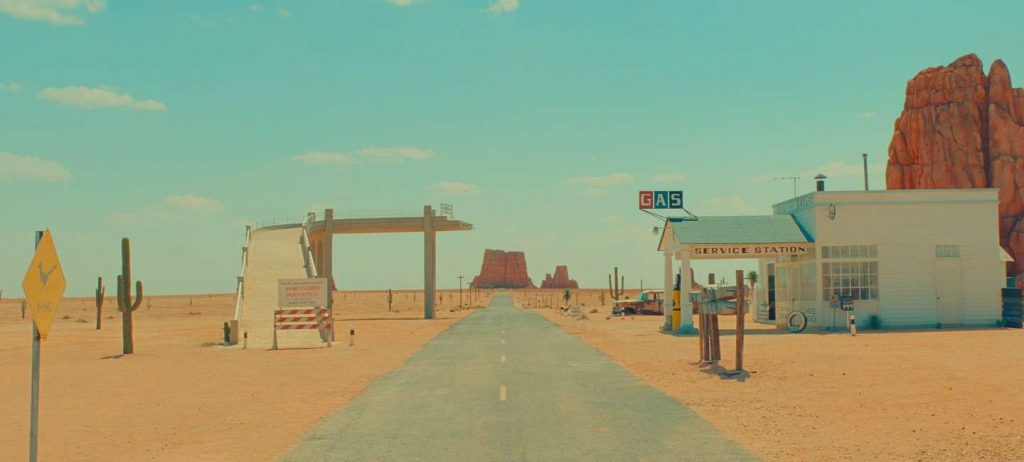//vol.15-3 Feature
Asteroid City: Wes Anderson’s Whimsical Summer Dream
by Mia Yao
Summer is almost over. But when you step into the cinema, your summer vacation gets extended under the harsh yet clean sunshine in a place called Asteroid City. Imagine this: a 650-car freight train, laden with cargo of cattle, grapefruit, avocadoes, agricultural tractors, and yes, even a nuclear warhead, chugs along the desert. You’re cruising with the family when your car decides to take a nap in the middle of nowhere. The result? An unexpected stay at a local motel, with your vehicle undergoing a spa session for cars.
But lo and behold, an alien has landed in the town during a youth astronomy convention, followed by quarantine sessions imposed by the military. People including you are stuck in the motel. When everything’s over one week later, you turn on the car engine and drive out of town. Nothing’s changed. Life marches on and repeats itself just like before, with or without meaning.
The whole experience mirrors the classic “Why do you want to dance?” “Why do you want to live?” dialogue that appeared in The Red Shoes. You ask yourself what is it all about? Why do you still want to tell the story, if there seems to be no meaning behind it?
The seemingly uneventful summer vacation is what American film director Wes Anderson tries to capture in his 11th movie Asteroid City. When it came out, the comedy received harsh criticism for its lack of substance, character development, plot and meaning. Some accuse it of being cartoonish and artificial while being too focused on style and world-building.
However, let’s give Anderson his due. The director, whose films have appeared three times in BBC’s poll of the 21st Century’s 100 greatest films (same as Christopher Nolan), surely faces grand expectations from the public. Starting from the bittersweet award-winning comedy – The Grand Budapest Hotel, Anderson’s intricately crafted narratives in a unique visual world, started to receive international recognition, inspiring young people and pop culture. The #accidentallywesanderson trend appeared on Instagram where young content makers began to reimagine their days in Andersonian vision. They post videos and photographs applying Anderson’s symmetric composition and well-composed colour palettes.
Unsurprisingly, when a new movie comes out with no major breakthroughs as one anticipated, but brimming with this post-Covid postmodernism and a sense of emptiness, reviewers get disappointed. Meanwhile those with lower expectations and less focus on meaning find themselves chuckling in the theatre over its one-of-a-kind absurdity and dry humour. The picture of an alien coming out from a green-lighted UFO gawking at war photographer Augie Steenbeck’s camera while holding an asteroid is just fun and lingers in my mind for the whole day.
Watching Asteroid City feels like recalling a long dream I had. Sometimes it is coloured but probably most of the time in black and white. When I recount it to my friends (if I still remember all the details), they listen, laugh and forget about it as time moves on. When Anderson makes it into a movie combining filmmaking and three-act plays, the dream becomes a whole other experience. The movie is not just experimental; it’s unique in its own style and highly consistent in terms of its theme, eccentricity, as well as unique visual and narrative styles.
Like before, Anderson touches upon emotions such as loneliness, damaged families, and abandonment. Drawing from his childhood witnessing parental divorce, he crafts cinematic opuses that ponder our kinship across time and space. In Asteroid City, Steenbeck’s four children have to face the harsh reality that their mom is dead and has been cremated in blue Tupperware. Steenbeck, breaking the parental script, decides to shatter the news that there are no such stars in heaven where dead people live, and that time doesn’t heal unfortunately.
Beyond family issues, Anderson explores another layer of human existence – the meaning of life post-Covid. The bizarre and knotty tale set in a remote desert town is written at the height of the Covid pandemic lockdown during the “most bizarre viral moment in recent history”, according to the director. Underneath Anderson’s cartoonish colour palettes, there is no fairytale but a world in chaos and disorder. “I still don’t understand the play,” the actor’s attempt to search for meaning ends up with nothing, while the play director in the movie tells him: “Doesn’t matter. Just keep telling the story.”
When life unfolds itself into an absurd play, simply play your part and tell the story, like every other actor on the stage. If we do need meaning in life, then this is the message.
At 54, Anderson is the Peter Pan of moviemaking – he’s no longer making silent films with his dad’s camera anymore, but he’s still that boy weaving unrealistic dreams into a clickety-clack train. As the audience chuckles at the oddity and embraces the absence of conventional plotlines, one wonders, who declared that dreams must adhere to plots? After all, in this cosmic carnival, even absurdity deserves a standing ovation.
Doesn’t matter. Just keep telling the story.
References
https://www.indiewire.com/features/interviews/wes-anderson-interview-asteroid-city-1234874967/
https://www.bbc.com/culture/article/20160819-the-21st-centurys-100-greatest-films
https://www.telegraph.co.uk/culture/film/starsandstories/10644172/Wes-Anderson-interview.html



